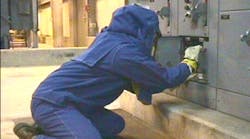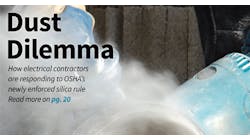Electrical hazards, specifically shock, arc flash, and arc blast, can result in serious injury or death to electrical workers. Work environments that create the potential for these events put everyone, including owners, at risk. However, many of these individuals fail to recognize these risks, thanks to several incorrect and dangerous beliefs that are ingrained in the electrical industry culture. Electricians may think that an electrical-related accident or injury can’t happen to them, or even worse, accept that the risks are just part of the job. When taken with many employers’ insistence that work be done hot, this belief creates the potential for serious injury. In fact, these ideals will often persist until a major electrical incident occurs and the personal and financial repercussions spur a change in policy.
Effecting change in the electrical safety culture doesn’t have to be a reactive process, though. Minimizing hazards like shock, arc flash, and arc blast is necessary for providing an electrically safe work environment. And the process of achieving this goal begins with the implementation and practice of five key electrical safety principles.
Electrical safety regulations and standards
The first key to electrical safety is to understand and follow safety regulations and standards. OSHA is the “law of the land” for electrical safety regulations. The OSHA Act of 1970 requires employers to provide employees with a workplace that is free from recognized hazards that could cause death or serious physical harm. Although not specifically stated, hazards such as electrical shock, arc flash, and arc blast would apply. Subpart S of OSHA 29 CFR Part 1910 “Standards for General Industry” contains electrical safety requirements that deal with protection from electrical hazards.
Because of these electrical hazards, the general rule of thumb is to not work hot. OSHA 1910.333(a)(1), requires live parts to be de-energized before an employee works on or near them unless de-energizing introduces additional or increased hazards or is infeasible due to equipment design or operational limitations. It’s important to understand that financial, convenience, or production concerns aren’t acceptable reasons to work on equipment hot. Failure to follow this OSHA requirement is a violation of federal law and can result in fines and/or criminal indictment.
Part II 2-1.1.1 of NFPA 70E-2000 “Standard for Electrical Safety Requirements for Employee Workplaces” has similar requirements. One difference, however, is that it uses the phrase “electrically safe work condition” instead of “de-energized.” It defines an electrically safe work condition as a state in which the conductor or circuit part to be worked on or near has been disconnected from energized parts, locked/tagged in accordance with established standards, tested to ensure the absence of voltage, and grounded if determined necessary. Part II 2-1.1.3 of the standard details the process for achieving an electrically safe work condition.
Electrical safety program
The second key electrical safety principle is to establish and follow an electrical safety program, which is the employer’s responsibility. The electrical safety program must be well thought-out, documented, and most importantly, put into practice. To develop an effective electrical safety program, all levels of personnel at a company or facility must be involved and committed to the program.
An essential part of any electrical safety program is training. OSHA 1910.332(b)(1) requires training for electrical safety-related work practices. This requirement is valid for both qualified and unqualified persons, and the level of training is based upon their respective job assignments. Similar to OSHA, NFPA 70E-2000 Part II 1-5 details electrical safety training requirements for qualified and unqualified persons.
NFPA 70E-2000 details other important requirements for an electrical safety program in Part II 2-3, including the following:
-
Awareness of electrical hazards and self-discipline of employees.
-
Identification of hazard/risk evaluation procedures.
-
Identification of electrically safe work procedures, tools, and personal protective equipment.
-
Identification of electrical safety principals, one of which is safety by design.
Electrical hazards
Understanding and identifying shock, arc flash, and arc blast is the third key electrical safety principle. Of these, electrical shock is the most common and well known. However, few are aware of the hazards presented by an electrical arcing fault and the resulting arc flash and arc blast, which cause severe electrical burns to more than 2,000 people in the United States each year.
An arc fault is initiated by current passing between two conducting metals through ionized gas or vapor caused by a flashover or other conductive material, such as a screwdriver. When an arc fault occurs, it produces an explosion with a significant amount of destructive energy.
The electrical arc produces temperatures that can exceed 35,000°F. This extreme temperature melts and vaporizes copper, which has an expansion ratio from solid to vapor of 67,000, as well as other materials. The high heat, arc flash, and molten metal can ignite clothing and cause fatal burns as far as 10 ft away. The vaporization and expansion of copper cause the arc blast itself, and the hot rapid-air expansion produces the immense sound and pressure waves as well as shrapnel. Pressure waves can rupture eardrums, collapse lungs, and propel workers across the room or cause them to fall from ladders. All of this occurs in a fraction of a second and will continue until the overcurrent protective device operates.
After the electrical hazards are understood, they must be identified in the workplace. NFPA 70E-2000 Part II 2-3.1.5 requires a hazard/risk evaluation procedure as part of an electrical safety program. The first step for this analysis is the determination of the shock approach boundaries. NFPA 70E-2000 details three approach boundaries in Part II 2-1.3.4 and 2-1.3.5 for qualified and unqualified persons. Permitted approach boundary distances to exposed energized electrical conductors based upon the voltage level are shown in NFPA 70E-2000 Part II Table 2-1.3.4.
The second step is to perform a flash hazard analysis as required by NFPA 70E-2000 Part II 2-1.3.3. The first part of this analysis is to determine the flash protection boundary distance per Part II, 2-1.3.3.2. This is the linear distance between the exposed body part, such as the chest or face, and the potential arc flash source for a just curable burn. This distance can be calculated or may be approximated as worst case provided certain conditions are met. The second part of this analysis is to determine the personal protective equipment (PPE) required per NFPA 70E-2000 Part II 2-1.3.3.3 for use if work is done within the flash protection boundary. This is based upon the incident energy, a measure of the thermal energy (in calories/cm2) at a specific distance from an arcing fault, often 18 in. One method for calculating the incident energy is shown in NFPA 70E-2000 Part II Appendix B-5.
A new method can be used to determine not only the flash protection boundary, but incident energy and required PPE as well. Based on the IEEE 1584 Standard “Guide for Performing the Arc Flash Hazard Calculations,” it contains newly developed formulas and details simplified methods for fuses and circuit breakers.
To better warn employees of electrical arc flash hazards, 110.16 of the 2002 NEC now requires labeling for equipment likely to require examination, adjustment, servicing, or maintenance while energized. The labeling, which should be placed on both new and existing equipment, should warn of the potential arc flash hazards and the requirement for PPE. It should identify flash hazard analysis information, such as the flash protection boundary, incident energy and required PPE, although currently not required by the NEC.
Work procedures, tools, and PPE
The fourth key electrical safety principal is to use safe work procedures, tools, and PPE. Electrical work must be planned before it is executed. All work procedures should be reviewed, updated, improved, and modified periodically as needed. For non-hazardous electrical work—equipment in an electrically safe work condition—the plan is typically unwritten but may be part of a general checklist and/or job briefing. For hazardous electrical work—energized or potentially energized equipment—a written procedure is usually required with documentation including a hazard/risk analysis detailing shock approach boundaries, flash hazard analysis, and a checklist of tasks.
OSHA 1910.333 covers the requirements for selection and use of work practices. The general requirement per OSHA 1910.333(a) is: “Safety-related work practices shall be employed to prevent electric shock or other injuries resulting from either direct or indirect electrical contacts, when work is performed near or on equipment or circuits which are or may be energized. The specific safety-related work practices shall be consistent with the nature and extent of the associated electrical hazards.”
The requirements for insulated tools, safeguards, and various types of personal protective equipment are detailed in OSHA 1910.335 and NFPA 70E-2000 Part II Chapter 3.
Safety by design
The final electrical safety principal is to increase electrical safety by design. One of the design considerations for electrical safety is to isolate the circuit. The use of isolation equipment to support preventive maintenance and repair for proper implementation of lockout/tagout procedures is an essential provision for electrical safety. This is especially important for motor loads and other loads that may require isolation for maintenance or repair purposes.
Another design consideration is to incorporate components or barriers that prevent the accidental contact of live parts. Components that are “finger-safe” or insulated barriers that prevent accidental contact provide increased protection from electrical shock and arc flash hazards during routine maintenance and troubleshooting.
Current-limitation can also be a key electrical design safety consideration. For example, current-limiting overcurrent devices can often be used to decrease the incident energy and arc flash hazards associated with arcing faults. By designing systems with current-limiting overcurrent devices, the flash protection boundary and level of PPE necessary may be able to be decreased. This can be an effective tool in increasing the feasibility of the task, such as checking for the absence of voltage while putting equipment into an electrically safe work condition.
The key electrical safety principles focus on the protection of owners, employers, and employees. To ensure a safer workplace, electrical professionals must change their existing cultures, beliefs and practices and follow electrical safety standards and regulations. By understanding electrical safety standards and regulations, establishing and following an electrical safety program, understanding and identifying electrical hazards, using safe work procedures, tools, and protective equipment, and improving electrical system safety by design, the electrical industry can work in a safer environment.
For more information, visit the following sites:
www.osha.gov
www.nfpa.org/catalog/product.asp?pid=70e00&src=nfpa
www.bussmann.com/apen/arcflash
Neeser is manager of technical sales, Cooper Bussmann, St. Louis.



